The best microphones in 2024: Boost voice quality at home
These are the best microphones to upgrade the sound quality of calls, gaming and audio projects, based on our testing
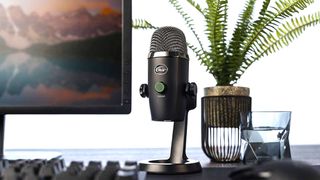
If you need to record yourself (or someone else, for that matter) on your computer, then you're going to want something better than the microphone that comes built-in. To that end, you're likely looking for one of the best USB microphones that plug into your machine, and give much better clarity and sound quality.
Of course, it's not just recording you might want a USB microphone for — you might be a streamer looking for something better than your headset mic, or a musician who wants to write some ballads at your desk. Whatever you need a mic for, we've made a comprehensive list of all the best USB microphones that we've tested so that you can find the best microphone for you.
Our favorite mic to buy right now is the Blue Yeti, the industry-standard USB microphone. If you've listened to a podcast in the last ten years, the likelihood is it was recorded with a Blue Yeti microphone. It balances ease of use with sound quality, and the solid stand in the box is a massive bonus.
There are other options that suit different uses and budgets as well, so read on to find the best USB microphone for you.
The Quick List

The Blue Yeti is ideal for multiple applications. Whether you're gaming of streaming, the quality is good enough for semi-professional recording, let alone in-game voice chat or Discord banter, and is as simple to set up.

As with the Blue Yeti — the best microphone overall — the JLab Talk is a great value alternative. It picks up speech with warmth and depth, and works well as soon as you plug in the USB cable.
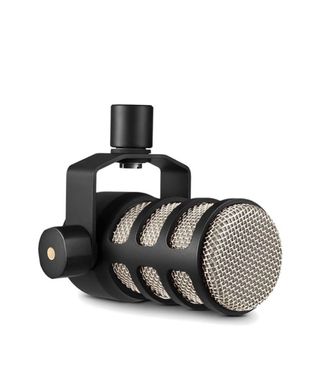
With studio credentials, the Rode PodMic is one of the best podcasting microphones. Its pro-style uses an XLR connector instead of USB and it delivers great sound.

With a stand, clamp, and mic in the box, this is a great way of getting started with a mic. The mic itself is a solid performer too, making it the perfect plug-and-play setup.

If you're looking for a USB microphone that won't break the bank, then you need look no further than the HyperX SoloCast. Solid sound not just for the price and an adjustable stand round out a great budget option.

With a shock mount and carrying case in the box, this Sterling microphone is a great option if you're just getting started with a podcast.
The best microphones you can buy right now
Why you can trust Tom's Guide
Most versatile microphone overall


Specifications
Reasons to buy
Reasons to avoid
I am a big fan of the Blue Yeti, as the rest of the world seems to be. There's a reason it's been available for purchase for over a decade, after all, and that's because it's really, really good. There's nothing that I can see that needs changing with the Blue Yeti — It's a smart, versatile microphone that doesn't cost a massive sum and gives you everything that even professionals need to record audio.
At its core, the Blue Yeti is a high-quality condenser mic with a built-in stand and that all-important USB port. But there’s more to it than just a simple USB microphone: There are four different pattern modes that you can select so that you can dial in your recording exactly as you want it.
You can record audio in cardioid, stereo, omnidirectional, or bidirectional modes. That means I can record a number of different sources, and make sure they sound as good as possible. A guitar, for example uses a different pattern to voice, and vice versa. It also means I could record a group of people, or just one with reasonable accuracy.
This isn’t something that other microphones offer, which tend to pick one pattern and stick with it. I’ve recorded D&D sessions with my Blue Yeti in omnidirectional mode, and then flipped it into cardioid mode mere hours later to record a guitar part for a song. It’s that flexibility that really helps the Blue Yeti become the best USB microphone around.
- Read the full Blue Yeti review
Best value microphone


Specifications
Reasons to buy
Reasons to avoid
The JLab talk is special to me because it manages some great performance at a bargain price, making home recording a whole lot more accessible to wider range of people and budgets. It helps that it’s a very solid recording device as well, with clarity and depth to it’s audio output.
You can pick one up for just $99, which brings in square into view of the Blue Yeti Nano — although it makes a more compelling request for your hard earned dollars. The feature set of the Talk puts it in line with more expensive options, with four switchable modes and a solid USB connection.
The same four modes are available as you’ll find on the Blue Yeti, including bidirectional, omnidirectional, cardioid, and stereo. While the some of the modes aren’t as crisp as you’ll find on more expensive models (Our testing revealed that the bidirectional mode wasn’t as consistent as omnidirectional mode, for example), stereo and cardioid are both excellent at capturing sound.
The fact that all this is available for such a low price is seriously impressive, and even if you’ve got more to spend on something more expensive, the Talk should be on your shortlist so that you can go and spend more on a pop filter or stand. Or more guests for your podcasts.
- Read our full JLab Talk review
Best microphone for podcasters

Specifications
Reasons to buy
Reasons to avoid
The Rode PodMic is a great premium feeling mic option — and while it might lack some of the microphone modes of those above it on this list, it’s an excellent choice for podcasters and voice-over recordings. It brings an internal pop filter to the table, and incredible recording quality. There is, however, one thing of note that you should know before you go and buy yourself a Rode PodMic: It’s not strictly a USB microphone.
The PodMic uses an XLR connector on the bottom of the microphone that doesn’t plug directly into your PC or Mac. Instead, you’ll need to plug that into a separate USB audio interface, lest ye will be out of microphone luck. Once you’ve got it hooked up there, however, you’ll soon find a very simple-to-use mic, with no controls on board — you manipulate its options with your audio recording software of choice.
It also doesn’t come with a stand, instead having an attached screw mount for you to affix to a boom arm or alternative fixing method. You could hardly call the PodMic plug-and-play, but once everything is hooked up together, you’ve got a top-quality mic that’s great for podcasting.
Why is good for podcasting, you ask? When we tested the microphone for a podcast, we discovered that it was able to isolate voices — even with a loud lawn mower buzzing and shouting loudly in the background.
- Read our full Rode PodMic review
Best USB mic package

Specifications
Reasons to buy
Reasons to avoid
The basic edition of the Sennheiser Profile USB microphone comes with an adequate table top/desk stand. We recommend opting for the $199 Streaming Set though, which comes with a boom arm, and transforms a cluttered desk into a studio ready for podcasting or streaming in 5 minutes.
Put together, the mic and boom arm are a match made in heaven. The boom arm has three points of motion for varying levels of access, and the mic screws in easily to provide quality sound. Both the mic and boom arm are sturdy. Plug the USB-C cable into your computer, and you're good to go.
While the externals of the mic and the boom arm are important, what really counts is on the inside. Sennheiser’s trademark German engineering shows up in the form of a cardioid condenser capsule that provides a great sound and keeps out the stuff we don’t want. The sound quality might change a bit with a desk stand, but one of the great advantages that comes with a boom arm is that the tapping on a desk or inadvertent bumps don’t show up nearly as much in the editing process. Although there's no pop filter supplied, this is a great-sounding USB mic streaming package at an honest price.
- Read our full Sennheiser Profile review
Best low-cost microphone
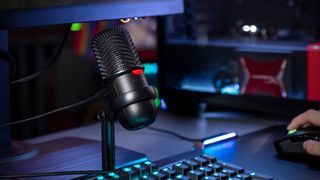
Specifications
Reasons to buy
Reasons to avoid
The HyperX SoloCast’s recording quality is a whole lot better than it should be for a $59 USB microphone. Its cardioid-pattern recording can compete with the category’s top performers, delivering rich, full vocals. You’ll notice less of an audible reverb effect when recording, as well as minimal background interference; noises like mouse clicks and mechanical keys aren’t as intrusive. We also love its compactness and adjustable stand to position the mic at different angles. There’s even an onboard mute button to prevent any incidental sounds from being picked up.
This mic comes plug-and-play ready and will meet the simplest accommodations such as basic controls and a single recording pattern, which is one of the very few features available. Still, this doesn’t take away from the SoloCast’s overall value.
- Read our full HyperX SoloCast review
Best for podcast beginners
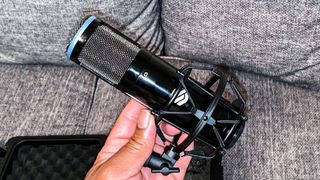
Specifications
Reasons to buy
Reasons to avoid
At $79, the Sterling SP150SMK is a reputable beginner mic for aspiring podcasters who want quality presentation at a low price. The mic is beautifully constructed, offering a nice look and feel that should have newbies feeling confident before uttering their intro lines. Additional accessories like a shock mount, hard mount option, and carrying case have you fully equipped to take your show on the road. Most importantly, the sound quality is top notch, picking up vocals with such precision that you’ll rarely have to perform any post-production adjustments.
Without high-pass filters, the SP150SMK has a tendency of picking up extraneous noises, such as an elbow rubbing against some fabric.
- Read our full Sterling SP150SMK review
Best wireless microphone for videographers and pros
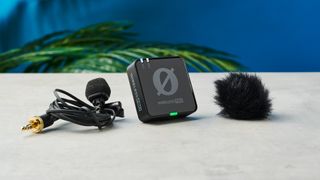
Specifications
Reasons to buy
Reasons to avoid
The Rode Wireless Pro is the best microphone for studio videographers, packing the professional features those shooters will need. It’ll also be great for high-end content creators, producing broadcast-quality footage for YouTube, as an example.
The Wireless Pro offers 32-bit float recording to capture a wide dynamic range and give high levels of flexibility in post production. There’s also an audio safety track, which captures a second audio track at -10dB to ensure any unexpected loud noises won’t completely ruin footage. And for creators who want to shoot video and audio separately, the Wireless Pro features timecode synchronization, making it easy to marry up files in post.
It isn’t perfect: controls are fiddly and you need to use the cumbersome companion app to access the full range of features. If you’re a content creator shooting or vlogging a lot on the move, the DJI Mic 2 is a better choice thanks to its intuitive and comprehensive onboard controls. All that said, the Rode Wireless Pro is still pro by name, pro by nature.
- Read our full Rode Wireless Pro review
Best shotgun microphone for content creation

Specifications
Reasons to buy
Reasons to avoid
Both beginner and amateur videographers should check out the Sennheiser MKE 400. This shotgun mic uses a highly directional supercardioid recording pattern to pick up clear speech, even when shooting in places with a lot of background noise.
What makes the MKE 400 particularly suitable for DIY content creation is how easy it is to use. While you can simply attach it to your camera's hot shoe and plug it in via 3.5mm cable, the MKE 400 offers this same plug-and-play simplicity for smartphones too. Simply connect via your handset's headphone jack and you can shoot great-sounding clips even without a DSLR or mirrorless camera.
- Read out full Sennheiser MKE 400 review
Best value gaming mic
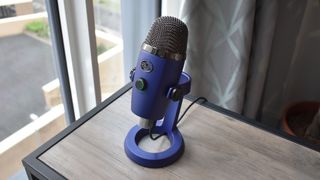
Specifications
Reasons to buy
Reasons to avoid
Yes, it's yet another Blue microphone, but the Yeti Nano is another top-quality USB microphone. It's basically a more compact, slightly stripped-back version of the flagship Blue Yeti, at an even better price.
That means you get very similar recording quality in its cardioid and omnidirectional patterns, plus mature looks and a tough metal build. For $99 the JLab Talk is an even bigger bargain, especially as it has a stereo mode, but the smaller Blue Yeti Nano still deserves a place on this list.
- Read our full Blue Yeti Nano review
Specs compared
| Header Cell - Column 0 | Mic type | Audio patterns | Connection type |
|---|---|---|---|
| Blue Yeti | Condenser | Bidirectional, Cardioid, Omnidirectional, Stereo | USB |
| JLab Talk | Condenser | Bidirectional, Cardioid, Omnidirectional, Stereo | USB |
| Rode PodMic | Condenser | Cardioid | 3-pin XLR |
| Sennheiser Profile | Condenser | Cardioid | USB |
| HyperX SoloCast | Condenser | Cardioid | USB-C-to-USB |
| Sterling SP150SMK | Condenser | Cardioid | 3-pin XLR |
| Sennheiser MKE 400 | Condenser | Supercardioid | 3.5mm jack |
| Blue Yeti Nano | Condenser | Cardiod, Omnidirectional | USB |
Also tested
Movo UM700: This is essentially a more affordable take on the Blue Yeti formula, albeit with a taller profile than the Blue Yeti Nano. =Although the UM700’s more famous rival edges it on general recording prowess, it’s more than up to the task for gaming, meetings and casual chats. Simply connect the USB cable, up the gain a little, and the UM700 is good to go. Read our full Movo UM700 review
HyperX Quadcast S: If you've got an RGB-heavy gaming PC and want a microphone to match, the more colorful QuadCast S is worth a look. The detail-rich recording quality is safeguarded by a built-in pop filter and shock mount, and it can easily be attached to your own stand if you'd prefer. Like the Blue Yeti and JLab Talk, is also provides four distinct recording modes, so you can tailor the settings for solo or group recording. Read our full HyperX QuadCast S review
Rode NT-USB Mini: This competent mic produces compelling recordings with decent audio. We appreciate the aux jack to connect headphones and hear your voice, along with the USB-C port that makes connecting to a desktop or laptop much simpler. The Rode NT-USB does have a gain issue, and adjusting it inside software won’t do much, but it can still be a serviceable product for newbie podcasters and streamers. Read our full Rode NT-USB Mini review
Things to consider when choosing a microphone
Setup: The best microphone depends almost entirely on your setup. This list gives a brief overview of all-purpose mics, podcasting mics, music mics and so forth. Basically, determine what you most need a microphone for, then find the appropriate one for your needs. As with most other gadgets, cheaper microphones tend to be more generalized, whereas more expensive ones tend to be more specialized. This doesn’t mean that cheaper microphones are inherently worse. But if you want semi-professional quality, you’ll have to pay semi-professional prices.
Research: Visit manufacturer websites, and learn about what each mic does best. The official website will usually give you a good idea as to whether the mic excels in podcasting, gaming, music or some other application. Failing that, remember that cardioid is generally the most useful audio pattern if you’re going to be recording by yourself in a home environment. Other patterns are good to have, but they’re useful only when you bring in more people or sound sources.
Pricing considerations: Obviously, price is a big consideration when looking for the best microphones. Although there are always exceptions, big-name brands will typically command a bit extra, but generally speaking, the less you spend on a microphone the greater the chance that performance and features will be compromised. Going for a budget option isn't always the best choice, as any money you save on your purchase won't do you much good if the sound quality is poor.
As the saying goes: timing is everything; and right now many of our favorite models are being discounted at online retailers, meaning you can bag a bargain for even less. Remember to bookmark our best tech deals page for all the latest savings.
What do the different audio patterns mean?
Microphone audio patterns explained
Some of the mics on this list offer different options for audio patterns: Bidirectional, cardioid, omnidirectional and stereo. Others offer only cardioid. Here's a brief explanation of each pattern, to help you decide which one to use:
Cardioid: This pattern picks up audio coming from one direction. This is ideal for a single source speaking directly into the mic, like in meetings or recording voiceovers.
Bidirectional: The pattern picks up audio coming from two directions only. This is ideal for two speakers sitting directly across from one another.
Omnidirectional: This pattern picks up audio from all around the mic. This is ideal for a whole group of people surrounding the microphone.
Stereo: This pattern picks up audio in front of the mic, as well as off to the sides. This is ideal for a musical group, or a panel of speakers facing the same direction.
More from Tom's Guide
Sign up to get the BEST of Tom's Guide direct to your inbox.
Here at Tom’s Guide our expert editors are committed to bringing you the best news, reviews and guides to help you stay informed and ahead of the curve!

After 2.5 years as Tom's Guide's audio editor, Lee has joined the passionate audio experts at audiograde.uk where he writes about luxury audio and Hi-Fi. As a former editor of the U.K.'s Hi-Fi Choice magazine, Lee is passionate about all kinds of audio tech and has been providing sound advice to enable consumers to make informed buying decisions since he joined Which? magazine as a product tester in the 1990s. Lee covers all things audio for Tom's Guide, including headphones, wireless speakers and soundbars and loves to connect and share the mindfulness benefits that listening to music in the very best quality can bring.
- Tammy RogersAudio Editor